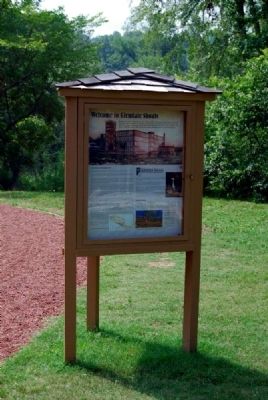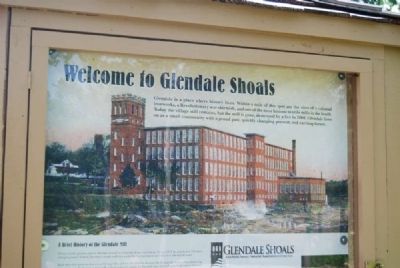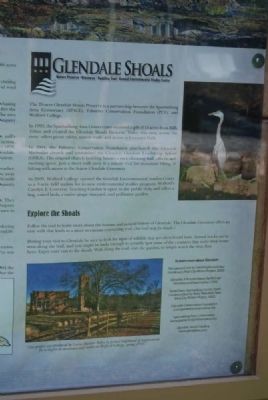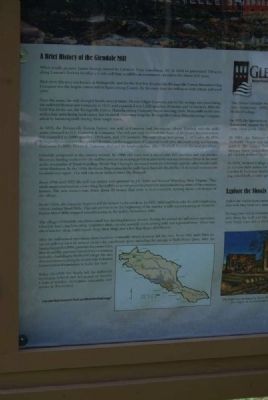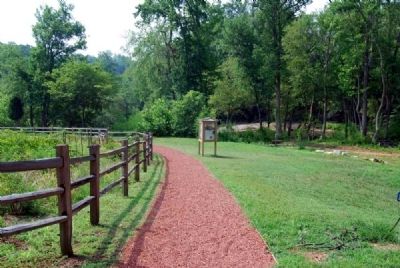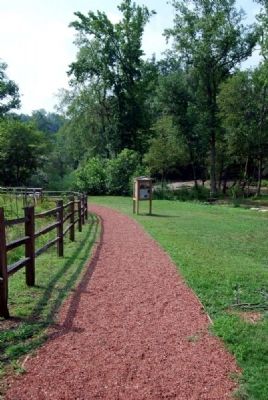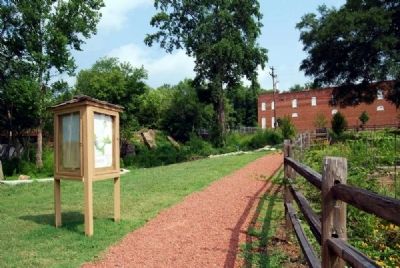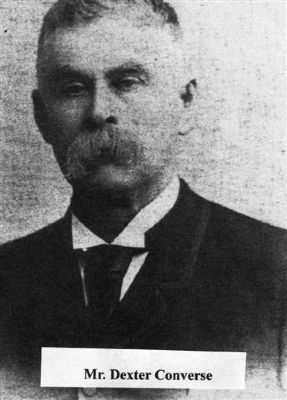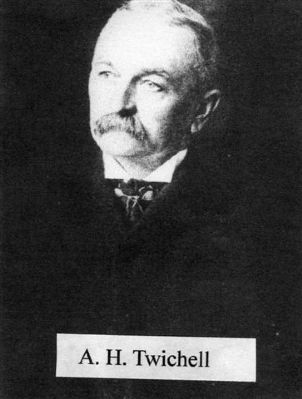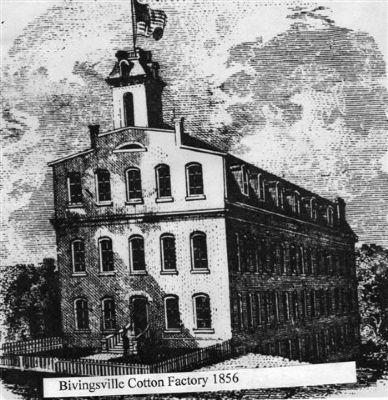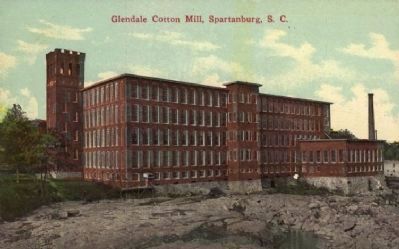Glendale in Spartanburg County, South Carolina — The American South (South Atlantic)
Welcome to Glendale Shoals
Glendale Shoals
— Nature Preserve • Greenway • Paddling Trail • Goodall Environmental Studies Center —
Glendale is a place where history lives. Within a mile of this spot are the sites of a colonial ironworks, a Revolutionary War skirmish, and one of the most historic textile mills in the South. Today, the village still remains, but the mill is gone, destroyed by a fire in 2004. Glendale lives on as a small community with a proud past, quickly changing present, and exciting future.
The 30-acre Glendale Shoals Preserve is a partnership between the Spartanburg Area Conservancy (SPACE), Palmetto Conservation Foundation (PCF), and Wofford College.
In 1993, the Spartanburg Area Conservancy received a gift of 13 acres from Billy Tobias and created the Glendale Shoals Preserve. Today this area, across the river, offers picnic tables, nature trails, and access to Lawson's Fork.
In 2004, the Palmetto Conservation Foundation purchased the Glendale Methodist church and established the Glendale Outdoor Leadership School (GOLS). The original church building houses a rock climbing wall, offices, and meeting space. Just a short walk away is a nature trail for mountain biking or hiking with access to the 6-acre Glendale Greenway.
In 2009, Wofford College opened the Goodall Environmental Studies Center as a 3-acre field station for its new environmental studies program. Wofford's Carolyn F. Converse Teaching Garden is open to the public daily and offers a bog, raised beds, a native grape vineyard, and pollinator garden.
A Brief History of the Glendale Mill
When textile pioneer James Bivings moved to Glendale from Lincolnton, NC in 1834 he purchased 750 acres along Lawson's Fork to develop a textile mill that would be in continuous operation for almost 150 years.
Back then this area was known as Bivingsville, and for the first few decades the Bivingsville Cotton Manufacturing Company was the largest cotton mill in Spartanburg County.
Over the years, the mill changed hands several times. Dexter Edgar Converse put his life savings into purchasing the mill with Bomar and Company in 1855, and expanded it to 1,435 spindles, 26 looms, and 58 workers. After the Civil War broke out, the Bivingsville Cotton Manufacturing Company began weaving cloth. Many mills in the area at this time were facing bankruptcy, but Dexter E. Converse keep the Bivingsville Cotton Manufacturing Company afloat by bartering cloth during these tough times.
In 1870, the Bivingsville Cotton factory was sold to Converse and his cousin, Albert Twichell, and the mill's name changed to D.E. Converse & Company. The mill not only survived the Panic of 1873 and Reconstruction, but expanded to 5,000 spindles, 120 looms, and 175 workers. The mill village had grown to 60 homes. In 1878, Bivingsville's name changed to Glendale, on the suggestion of Converse's wife after she made a trip to Glendale, California. In 1899, Dexter E. Converse died and his brother-in-law, Albert Twichell, became the next president.
Glendale prospered as the century turned. By 1900, the town had a school with 125 students and one teacher. However, finding workers for the mill became an increasing problem and workers were recruited from as far away as the mountains of North Carolina. World War I brought increased work for Glendale and the other textile mills of the Piedmont. In the 1930s the Great Depression hit the mills hard, but with World War II the textile community boomed once again. The mill ran three shifts to meet the demand.
From 1946 until 1957 the mill was owned and operated by J.L. Stifel and Sons of Wheeling, West Virginia. They made major renovations, concerting the mill from steam power to electricity and remodeling many of the company houses. The new owners town down about 35 houses they were in bad condition, leaving about 120 houses in the village.
In the 1950s, the company began to sell the houses to the workers. In 1957 Stifel and Sons sold the mill (employing 600) to Indian Head Mills. The sale proved to be the beginning of the end for textile manufacturing in Glendale. Indian Head Mills stopped manufacturing in the mill in November 1961.
The village of Glendale once had a small but thriving business district. During the period the mill was in operation, Glendale had a machine shop, carpenter shop, circular sawmill, wool-carding mill, and a general store. There was also a butcher shop, radio repair shop, show shop, and a hot dog shop called Reeves.
After the mill ceased operations these businesses eventually closed down or left the area. from 1961 until 2004 the vacant mill was used by several owners for warehouse space including the storage of Rolls Royce parts. After the factory burned in 2004, present-day owner Glyn Morris and his partners donated the remaining mill office building to Wofford College. He also donated six acres along the river to the Palmetto Conservation Foundation to build this trail.
Today Glendale has finally left the industrial revolution behind and it's posed to become a hub of tourism, recreation, education, and service in this century.
Explore the Shoals
Follow the trail to learn more about the human and natural history of Glendale. The Glendale Greenway offers an easy walk that leads to a more strenuous connecting trail.
During your visit to Glendale be sure to look for signs of wildlife that are often found here. Animal tracks can be seen along the trail, and you might be lucky enough to actually spot some of the creatures that make their home here. enjoy your visit to the shoals. Walk along the trail, visit the garden, or simply watch the river flow.
Erected 2009 by Glendale Shoals Preserve.
Topics. This historical marker is listed in these topic lists: Industry & Commerce • Waterways & Vessels. A significant historical month for this entry is November 1961.
Location. 34° 56.5′ N, 81° 50.283′ W. Marker is in Glendale, South Carolina, in Spartanburg County. Marker can be reached from Broadway Street. Touch for map. Marker is at or near this postal address: 351 Broadway Street, Glendale SC 29346, United States of America. Touch for directions.
Other nearby markers. At least 10 other markers are within 5 miles of this marker, measured as the crow flies. Camp Croft (approx. 1.7 miles away); Battle of Cedar Spring (approx. 3.1 miles away); Clifton Baptist Church / First Baptist Church (approx. 3.3 miles away); Clifton World War II Memorial (approx. 3.3 miles away); Pacolet River Heritage Preserve (approx. 3.4 miles away); The Pacolet River Flood of 1903 (approx. 3.6 miles away); American Legion Memorial Archway (approx. 4.1 miles away); Spartanburg County War Memorial (approx. 4.1 miles away); Purple Heart Memorial (approx. 4.1 miles away); Spartanburg Confederate War Monument (approx. 4.4 miles away).
Also see . . .
1. Glendale, South Carolina: Past - Present - Future. This web site is intended to be a place of reunion, a place of memory and a place of celebration of the town of Glendale and its people. (Submitted on July 11, 2011, by Brian Scott of Anderson, South Carolina.)
2. D.E. Converse Co. & Glendale Mill Presidents 1870-1957. According to the records which I have, the Bivingsville Manufacturing Company, Bivingsville, S.C., having fallen into bankruptcy, was sold to John Bomar Jr. and his associates at a Sheriff’s sale for $19,500 in 1856. (Submitted on July 11, 2011, by Brian Scott of Anderson, South Carolina.)
3. Digital Glendale Shoals. Digital Glendale Shoals collects and provides access to photographs, plans, and documents pertaining to the formation of the Wofford College Environmental Studies program and Goodall Environmental Studies Center at Glendale Shoals. (Submitted on July 11, 2011, by Brian Scott of Anderson, South Carolina.)
Additional commentary.
1. Mill Goes Up in Flames
Spartanburg Herald-Journal
By Susan Orr and Janet S. Spencer
Glendale -- Fourteen-year-old Zach Ivey knelt in the street and put the palms of his hands down, leveling his back Saturday afternoon so his friend, Dustin Roberts, could use it as a platform to photograph the still-smoldering Glendale Mill.
Roberts, 15, snapped a few shots as thick smoke continued to roll from the ruins 15 hours after a fire left only the brick wall outline of the 137-year-old, five-story structure.
"This place is historical," Ivey said when Roberts jumped from his back. "We studied about it in school."
Working their way back up the street, the teens pulled a shiny, red Radio Flyer wagon they had hoped to use for a better vantage point. But when the authorities would not let them take it in, Ivey gave Roberts the boost he needed for the photography session.
"We've been around here watching since 3 a.m.," said Roberts, a student at Broome High School. "At first, we thought it was our friend's house. We came running down here to be sure he was alright."
The teens were wide-eyed as they talked about the blaze that gutted the mill, which closed 43 years ago.
"It was terrible. Those flames were just so high," Ivey said, throwing his head back and looking into the sky.
They stood in front of a house facing the mill that was the only other structure damaged by the roaring early morning blaze that sent red and yellow flames high into the air, said Glendale Assistant Fire Chief Eric Alley.
Alley said he was on duty at the station just down the street when the call to 911 came in at 2:26 a.m. Saturday.
In addition to numerous rows of houses, which had to be protected from the heat and blaze, the Post Office is adjacent to the property and its operation was shut down for the day. Also within a half-mile radius of the mill are the Spartanburg County District 3 school administrative offices and at least five churches.
More than 80 firefighters from the Glendale, Pacolet, Converse and Drayton departments responded and rotated working throughout the day trying to extinguish the blaze and prevent it from spreading.
A crew of firefighters was assigned to remain overnight to keep the blaze from rekindling. Agents with the State Law Enforcement Division called to the scene to determine the cause waited for what was left to cool so they could begin their work.
"When I pulled in, the back part of the mill – the three-story section -- was fully engulfed in flames," Alley said. "It's a total loss. Everything's gone, except a small newer office addition here closest to the post office," Alley said. "Right now we're just working to keep the hot spots down."
Anderson-based Glendale Development Corp. owned the 250,000-square-foot mill. Several companies were leasing space for storage, according to Glendale Development President Mike Cicora.
Cicora, whose group bought the mill in 2000, said he learned about the fire when a friend called him Saturday morning after seeing a report on television.
He said there were plans to redevelop the mill, possibly turning it into condominiums. "It may have looked like there was nothing happening, but we had strong interest from several different groups," Cicora said. "There were no immediate plans, but certainly there were plans for developing the property. I'm absolutely devastated by this. Three and a half years of my life literally went up in smoke."
The mill was built about 1867, and the site along Lawson's Fork Creek has an even richer history. It was first developed in 1773, when Joseph Buffington built Buffington Iron Works. But Buffington struggled and eventually lost the facility to William Wofford in a land dispute.
During the Revolutionary War, British soldiers ambushed American forces that had camped out at Wofford's Iron Works on Aug. 7, 1780. The Americans fought off their attackers and the foundry was spared.
A year later, the iron works was destroyed in a raid led by "Bloody" Bill Cunningham. But it reopened after the war as South Carolina Iron works. James Bivings of Lincolnton, N.C., bought the property and built the Bivingsville Cotton Factory in the early 1830s. It was South Carolina's first cotton mill with more than 1,000 spindles.
The mill went bankrupt in 1855, and Bivings sold it to John Bomar and Co. for $19,500 a year later. Bomar's group hired Edgar Converse to run the operation. The mill flourished under Converse, and during the Civil War a third of the plant's production went to the Confederate government.
The factory was razed after the war and a new mill – the one that burned Saturday morning -- was built around 1867. The company also had a new name – D.E. Converse and Co. The name of the mill was changed to Glendale in 1878. Another section was added in 1890, and another expansion occurred in 1902. By 1907 it had more than 37,000 spindles.
Stifel and Sons of Wheeling, W.Va., bought the mill in 1946. Stifel remodeled the mill village homes and sold them to the employees in 1955. Indian Head Mills bought the facility in 1957. Four years later, the looms stopped running for good.
Neighbors and motorists following the smoke continued to gather and watch the activity of firefighters throughout the day. Several people reported hearing large booms that awakened them.
Witnesses said it took firefighters two or three hours to get the blaze under control, and as late as noon an isolated patch of fire could still be seen amid the rubble.
Ray Price, a firefighter and photographer for the Glendale Fire Department, said the mill's size and condition made this the worst fire he had ever seen in his 30 years of photographing fires for documentation and training purposes. Many people walked around surveying the scene and documenting the mill's demise by shooting photos and video images.
Broadway Street resident Tim Williams learned of the fire at 2:35 a.m. when a neighbor called him. He soon got an up-close look at the blaze when he helped a friend move a dump truck and other vehicles the friend had stored behind the mill.
Driving on an access road behind the mill, Williams saw burning embers falling through the air and bricks flying out of windows.
"It looked like volcano rocks falling down," Williams said. "I had my (vehicle) windows up and my air conditioner on and it was burning my face, it was so hot." But Williams said the only damage to his vehicle was some soot marks.
Donald Hughes, another Broadway Street resident, lives a block or so from the mill and he said the flames were so intense that they lit up the darkness.
"I live on the top of the hill and when I walked outside it was like broad daylight," Hughes said. Hughes believes that if the wind had not shifted and blown flames away from the mill village that many mill houses would have succumbed to the blaze.
The fire was especially threatening to Hughes' mother, Dee Bryant, who lives on Glendale Avenue right across from the mill.
She woke up around 2 a.m. when she heard a loud explosion, and when she looked outside she saw towers of flames. "I was freaking out," Bryant said.
Once the fire spread to the part of the mill closest to her home, the heat was so intense that it began to melt her vinyl siding.
Neighbors tried to wet her home with a garden hose, but the water pressure was too low so Drayton's fire department had to come and spray Bryant's house in order to save it. "Thank goodness for Drayton," she said.
John Bishop of Duncan Street, a lifelong Glendale resident who worked at the mill as a teenager, said he was sorry to see the mill gone because of its history. "It went down in a hurry," Bishop said. "In about two or three hours, it was down."
— Submitted July 11, 2011, by Brian Scott of Anderson, South Carolina.
Credits. This page was last revised on August 5, 2021. It was originally submitted on July 11, 2011, by Brian Scott of Anderson, South Carolina. This page has been viewed 2,251 times since then and 158 times this year. Photos: 1, 2, 3, 4, 5, 6, 7, 8, 9, 10. submitted on July 11, 2011, by Brian Scott of Anderson, South Carolina. 11. submitted on November 2, 2008, by Brian Scott of Anderson, South Carolina.
